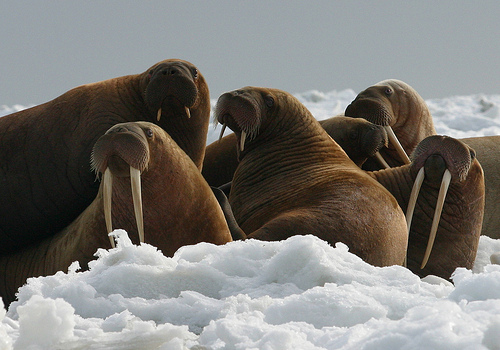Zack Strong, Wildlife Advocate, Bozeman, Montana
Huge, tough, impervious to cold. Long, sharp tusks. Fierce enough to defend themselves against polar bears and killer whales. A diet of shellfish that many cultures consider delicacies. It’s hard to believe that walruses would have much to worry about, or that the world’s walrus populations could be in trouble.
Unfortunately, there is reason for serious concern. The Alaska Dispatch recently reported that, for the sixth time in the last seven years, thousands of Pacific walruses had hauled out on the northwestern Alaska coast near the village of Point Lay, high above the Arctic Circle. Although they occasionally haul out on shore, prior to 2007, walruses had never been seen hauled out in that area, so far north.
These haul outs have coincided with years when the late-summer pack ice has receded north of the relatively shallow continental shelf underlying the Chukchi and Beaufort Seas. Once the ice withdraws to the much deeper waters of the Arctic Basin, walruses are unable to dive deep enough to reach the ocean floor to feed. As a result, they are forced to abandon the retreating pack ice and haul out on land, instead. This is a big problem, for a number of reasons.
For one, unlike many other marine and arctic-dwelling animals, walruses are not (by comparison) endurance athletes. They get tired. Between forays to the ocean floor to feed on clams, crabs, snails, worms, sea cucumbers and other “benthic” (ocean bottom) delights, they need to rest. Typically, walruses (especially female and young Pacific walruses) haul out onto ice bergs floating directly above the foraging site, and use the bergs like over-sized chaise lounges to sleep, socialize, and nurse their young. Once they have recovered, and the pups are well fed, the adults can simply roll over into the water and drift back down to the dinner plate waiting below.
A lack of ice, and relocation to land haul outs, means that, instead of resting, walruses may have to expend enormous amounts of energy traveling 120 miles or more (one way) between their favorite foraging areas (such as the Hanna Shoal, in the northeastern Chukchi Sea) and the shore. More energy spent traveling by lactating females may also mean a reduced ability to produce milk for pups, jeopardizing their survival.
Walruses hauled out on land, where they cannot escape as easily into the water, are more susceptible to predation by polar bears. And because they congregate in such large numbers on shore, stampedes can also prove fatal—especially for younger animals. In 2007, scientists reported that more than 3,000 walruses—mostly calves—were crushed in stampedes when a herd of as many as 40,000 animals congregated on shore due to lack of sea ice. These large congregations also mean that local food supplies might be quickly exhausted, requiring walruses to travel further and further distances to forage.
As “benthic bioturbators” (they churn up the ocean floor while foraging, which releases nutrients), the importance of walruses’ role in marine ecosystems is clear. Their future, however, is anything but. According to the latest climate report by the Intergovernmental Panel on Climate Change, “it is very likely that the Arctic sea ice cover will continue to shrink and thin.”
Further, the most recent population survey of Pacific Walruses showed that the entire population may have dwindled from 201,000 in 1990 to just 129,000 in 2006. In 2011, the U.S. Fish and Wildlife Service (FWS) found that listing the Pacific walrus as threatened or endangered was warranted but precluded. And just this summer, FWS decided to issue regulations that will allow offshore oil and gas drilling activities in the Chukchi Sea to harass, disturb, and disrupt the “migration, breathing, nursing, breeding, feeding [and] sheltering” of Pacific walruses (and polar bears)—despite our urgent opposition.
But walruses are tough, adaptable, and resilient. With a little help, the Pacific population has recovered from severe depletion by past commercial hunting. With a little more (like NRDC’s work to curb global warming, encourage renewable energy, and oppose offshore drilling in the Polar Bear Seas), we can help make sure the Arctic remains the cold, quiet, icy world that walruses need to live—and lounge—in peace.
(Top photo of walrus cows and yearlings by USFWSAlaska on Flickr; bottom photo of napping walruses by claumoho on Flickr)
Related articles





